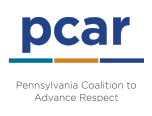Sexual violence is a term meant to include any type of unwanted sexual contact. This can include words and actions of a sexual nature including, but not limited to:
- Rape
- Sexual assault
- Incest
- Child sexual assault
- Grabbing or groping
- Ritual abuse
- Commerical sexual exploitation (i.e. prostitution)
- Sexual harassment
- Sexual or anti-LGBTQ bullying
- Exposure and voyeurism
- Forced participation in the production of pornography
Child sexual abuse is physical or non-physical contact between an adult or minor and a child which results in sexual stimulation and the gratification for the adult or minor. Child sexual abuse is often a gradual process, with the adult deliberately testing the child's boundaries using his or her familiarity with the child, social status, or power to take advantage of the child.
This process, call 'grooming,' often happens by building trust of the child and adults responsible for the child's welfare, giving gifts or favors, separating the child from others, creating a norm of secrecy for other activities and violating boundaries. The adult often will use grooming techniques to create opportunities to commit sexual acts on a child.
Child sexual abuse includes acts of physical touch such as rape or sexual assault. Non-touching behaviors like exposing children to adult sexual activity or sexualized talk are also sexual abuse.
A person may use
- force
- threats
- manipulation
- coercion to commit sexual violence.
There is a social context that surrounds sexual violence. Social norms that
- condone violence
- using power over others
- traditional constructs of masculinity
- the subjugation of women
- silence about violence and abuse contribute to the occurrence of sexual violence
Oppression in all of its forms is among the root causes of sexual violence. Sexual violence is preventable through collaborations of community members at multiple levels of society—in our homes, neighborhoods, schools, faith settings, workplaces, and other settings. We all play a role in preventing sexual violence and establishing norms of respect, safety, equality and helping others.
Child sexual abuse is an exploitation of power that takes away a child’s right to healthy and trusting relationships.
Related: Learn examples of child sexual abuse
Sexual abuse can happen at any age, but children and teens are at highest risk.
Young children depend on adults for basic care and safety. The more dependent children are, the more at risk they are.
- 12.3% of female victims of rape were first raped when they were 10 or younger (Black et al., 2011).
- 27.8% of male victims of rape were first raped when they were 10 or younger (Black et al., 2011).
A child is sexually abused when they are exposed to sexual acts or behaviors.
Individuals who sexually abuse children look and act like nice people, holding positions of trust and power. They can be caregivers, family members, friends, neighbors, healthcare providers, leaders of faith communities, teachers or coaches.
Most of the time the child knows their abuser.
- 37% are biological parents.
- 23% are non-biological parents or parents’ partners.
- 40% are other (including family members and non-family members).
(Sedlak et al., 2010)
Blurring boundaries, giving attention and gaining trust are all part of a process that starts long before an abusive act occurs. All of these things help the abuser go undetected by both children and adults around them.
Related:
What behaviors might a person who sexually abuses children use to gain trust?
What people who sexually assaulted children said they were looking for in a child
Child sexual abuse thrives in a world of silence, secrecy and shame. Less than one victim in 12 will tell. There are many reasons why children don’t tell about abuse. They may feel they are responsible for the abuse or worry that they won’t be believed.
Related:
Learn more about why children often remain silent after abuse
Child sexual abuse is not just a bad experience. Child sexual abuse wrecks young lives—victims of child sexual abuse are at greater risk for psychological disorders such as depression and Post Traumatic Stress Disorder, substance abuse and relationship problems.
Related:
Caring adults must learn to spot behavior changes, listen to children and act to protect them from abuse. We must all create a space where children are safe, valued and believed.
Related:
How can I protect my child from sexual abuse?
What are some warning signs of sexual abuse?
If you suspect a child is being abused, trust your instincts. You can report suspected child abuse by calling CHILDLINE at 1-800-932-0313. If you are not sure what to do, call 1-888-772-7227 to speak with a counselor who can answer your questions and help you feel more confident in your decision. Mandated reporters can submit a report online via the Child Welfare Portal.
Related:
Learn more about reporting child sexual abuse
What can I do to create a safe community for children?
Help the children in your life grow up free from sexual violence
What if a child tells me she/he is being abused?
Online Safety for Children and Teenagers
References
Black, M.C., Basile, K.C., Breiding, M.J., Smith, S.G., Walters, M.L., Merrick, M.T., Chen, J., & Stevens, M.R. (2011). The National Intimate Partner and Sexual Violence Survey (NISVS): 2010 summary report. Atlanta, GA: National Center for Injury Prevention and Control, Centers for Disease Control and Prevention. Retrieved from http://www.cdc.gov/ViolencePrevention/pdf/NISVS_Report2010-a.pdf
Sedlak, A.J., Mettenburg, J., Basena, M., Petta, I., McPherson, K., Greene, A., and Li, S. (2010). Fourth National Incidence Study of Child Abuse and Neglect (NIS–4): Report to Congress. Washington, DC: U.S. Department of Health and Human Services, Administration for Children and Families. Retrieved from http://www.acf.hhs.gov/programs/opre/resource/fourth-national-incidence-study-of-child-abuse-and-neglect-nis-4-report-to
